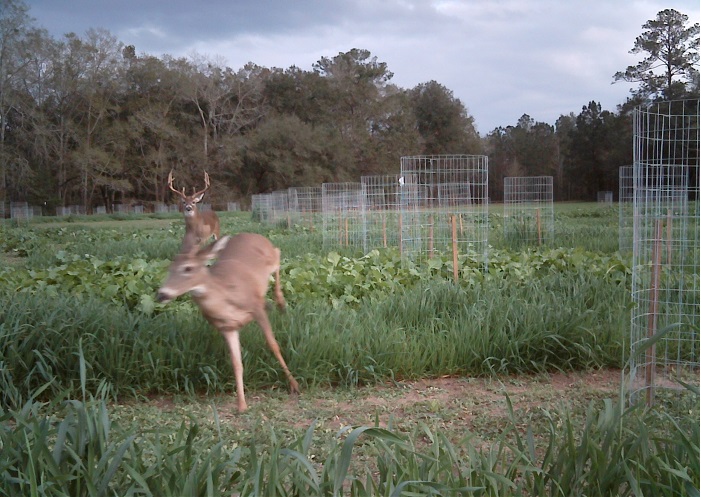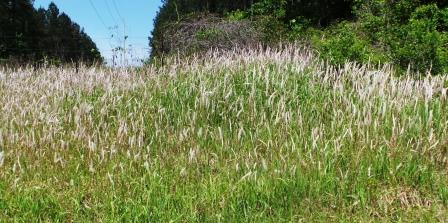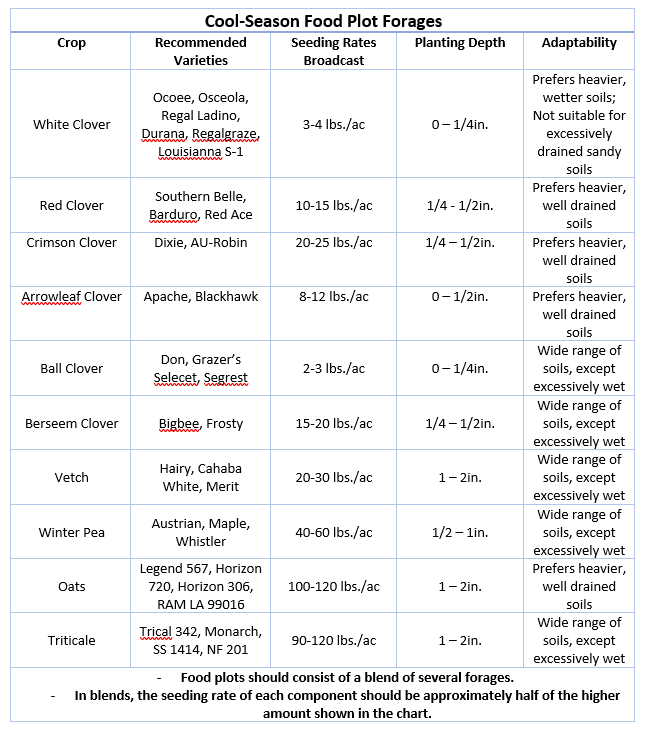
A buck chases a doe through plots of wildlife forages being evaluated at the University of Florida’s North Florida Research and Education Center. Photo Courtesy of Holly Ober
I know it feels too hot outside to talk about hunting season or cool-season food plots, but planting time will be here before you know it and now’s the time to start preparing. The recommended planting date for practically all cool-season forage crops in Northwest Florida is October 1 – November 15. Assuming adequate soil moisture, planting during the first half of the range is preferred. Between now and planting time there are several factors that need to be considered and addressed.
Invasive and/or Perennial Weed Control – Deer and other wildlife species utilize many soft/annual “weeds” as forage so controlling them is usually not a major concern. But from time to time unwanted perennials (grasses and woody shrubs) need to be controlled. An unfortunate and all too common example of and unwanted perennial is cogongrass – a highly invasive grass that should always be controlled if found. Effective control of perennial weeds, like cogongrass generally involves the use of herbicides. Late summer/early fall is a very effective time to treat unwanted perennials. Fortunately, this coincides well with the transition between warm-season and cool-season forages. If you have unwanted, perennial weeds in your food plots get them identified now and controlled before you plant your cool-season forages.

Cogongrass shown here with seedheads – more typically seen in the spring. If you suspect you have cogongrass in or around your food plots please consult your UF/IFAS Extension Agent how control options.
Photo credit: Mark Mauldin
Soil Fertility Management – In my experience, the most common cause for poor plant performance in food plots is inadequate soil fertility. Before planting time collect and submit soil samples from each of your food plots. Laboratory analysis of the samples will let you know the fertilizer and lime requirements of the upcoming cool-season crop. It is very important to have the analysis performed prior to planting so performance hindering issues can be prevented. Otherwise, during the growing season, by the time you realize something is wrong, it will likely be too late to effectively address the problem. This is particularly true if the issue is related to soil pH. To affect soil pH in a timely manner lime needs to be incorporated into the soil. Incorporation is impossible after the new crop has been planted. Soil analysis performed at the University of Florida’s Extension Soil Testing Lab cost $7 per sample. Your county’s UF/IFAS Extension Agent can assist you with the collection and submission process as well as help you interpret the results.
Variety Selection & Seed Sourcing – Sometimes it takes some time to find the best products/varieties. Just because forage seeds are sold locally doesn’t mean that the crop or specific variety is well suited to this area. The high temperatures and disease pressure associated with Florida, even in the “cool-season” mean that many products that do very well in other parts of the country may struggle here. Below are some specific forages that are favored by wildlife (specifically white-tailed deer) and generally well adapted to Florida. You may discover that these varieties are not sitting on the shelf at the local feed & seed. Often local suppliers can get specific varieties, but they must be special ordered, which adds time to the process. Hence the need to start planning and sourcing seed early.
If you are debating trying food plots on your property for the first time, please carefully consider the following. Food plots are not easy – Making productive food plots that provide a measurable, positive impact to the wildlife on your property takes considerable time, effort, and money. Considering this, food plots really only make sense when viewed as habitat improvements that provide long term benefits to multiple wildlife species. If you are looking for nothing more than a deer attractant during hunting season food plots are not a very practical option. For more information on getting started with food plots contact your county’s UF/IFAS Extension Office and check out the reference below.
- Establishing and Maintaining Wildlife Food Sources
- Underperforming Food Plots? 3 Possible Reasons why
- Food Plots Can Benefit Deer and Hunters
- Now’s the Time to Start Preparing for Hunting Season
- Fall is an Excellent Time to Manage Vegetation - October 21, 2025
- Believe It or Not, It’s Time to Start Working on Cool-Season Food Plots - August 4, 2025
- Fall is Here, It’s Time to Spray Cogongrass - October 11, 2024

